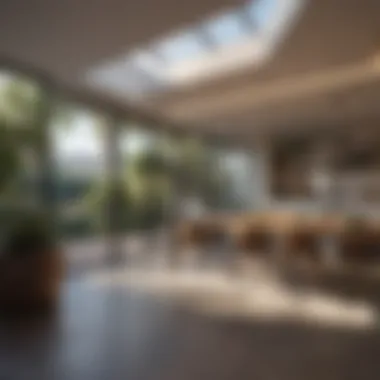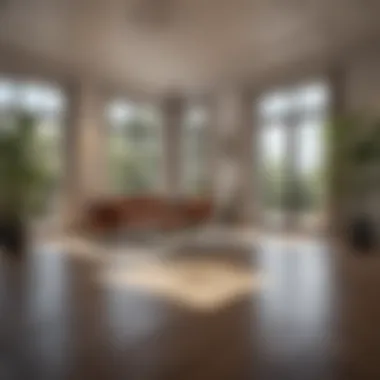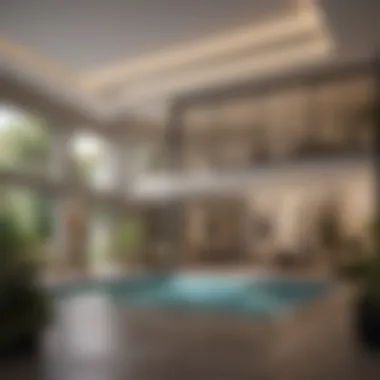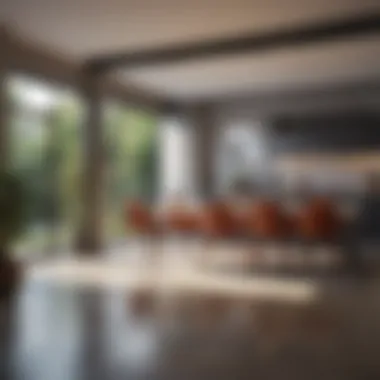Discover the Advantages of 3D Tours in Rental Homes


Intro
The advent of 3D tours has marked a shift in the real estate rental market. As potential tenants search for their next home, the ability to explore properties remotely offers significant advantages. In this article, the impact of 3D technology on house hunting will be examined, highlighting how it enhances the experience for both landlords and renters.
Contrary to traditional methods, which often rely on photographs alone, 3D tours provide a more immersive view of a rental property. This analytical approach allows potential tenants to visualize space in a manner that static images cannot. As the real estate landscape evolves, understanding the relevance and implications of integrating this technology becomes essential for those involved in the rental market.
With various technological advancements, 3D tours are now accessible to a broader audience. They play a critical role in the decision-making process for potential tenants by allowing for in-depth virtual exploration. The effects on customer satisfaction and the efficiency of property showings will also be discussed, emphasizing their value in a competitive market.
As we delve into this topic, we will uncover the practical implications of implementing 3D tours, not only for landlords aiming to attract tenants but also for individuals looking for their ideal living space.
Overall, the integration of 3D tours into real estate rental practices stands as a testament to innovation in a field that, historically, has taken a traditional approach. The following sections will explore the various benefits and detail how this technology is shaping the future of house hunting.
Foreword to 3D Tours in Real Estate
The advancement of technology has introduced many changes in how we interact with real estate. 3D tours are an important development in this sector. They provide a virtual way to experience properties. This section explores their role and significance in the housing rental market.
Definition and Overview of 3D Tours
3D tours, often referred to as virtual tours, allow potential renters to explore a property remotely. Unlike traditional photos or videos, these tours use 3D imaging to create an immersive experience. Viewers can navigate through a space, observing details from various angles. Users can see how rooms connect, allowing a better understanding of the layout.
This technology usually involves a special camera that captures 360-degree images of a property. Then, these images are processed into a comprehensive view that mimics a physical walkthrough. The key benefit lies in the level of interaction offered to users. They can take control of their viewing experience.
Emergence of 3D Technology in Real Estate
The emergence of 3D technology in real estate traces back to the growing demand for innovation in house hunting. Home seekers desire more than static imagery; they wish for a dynamic and informative exploration. 3D tours began to rise in popularity about a decade ago. As tablets and smartphones became common, access to such technology also improved.
Real estate companies recognized this trend. Many started to adopt 3D technology. They sought to attract tech-savvy consumers who value convenience. The integration of software tools and platforms designed for real estate further facilitated this transition. Virtual reality also plays a role in enhancing the user experience, by making tours feel even more engaging.
In summary, 3D tours reflect a significant shift in real estate marketing strategies. They meet contemporary consumer expectations, combining convenience with detailed exploration. Understanding this context is crucial to grasping the overall impact of 3D tours in the rental market.
The Shift in House-Hunting Techniques
The landscape of house-hunting has evolved significantly with advances in technology. For many renters, finding an ideal place to live used to involve physically visiting numerous properties, often resulting in frustration and wasted time. Now, with the introduction of 3D tours, this process has become more efficient and user-friendly. These virtual experiences allow potential tenants to explore properties from the comfort of their homes. As we delve into this section, we will explore how these changes have improved the overall renting experience and adjusted consumer expectations in the real estate market.
Comparison to Traditional Viewing Methods
Traditionally, house-hunting involved scheduling viewings and traveling to various locations. This often required considerable effort, including coordinating times with multiple landlords and managing travel logistics. In contrast, 3D tours eliminate much of this hassle. They provide immersive experiences that offer a comprehensive view of a property.
- Convenience: Renters can view several properties in one sitting, without the need to physically be present.
- Real-time Exploration: Through 3D tours, potential tenants can take their time to examine details, such as room dimensions or the layout, something that is often rushed during a physical showing.
Moreover, 3D tours portray the property's ambiance better than photographs, capturing the nuances of light and space. Traditional pictures often do not convey the true feel of a home, leading to mismatched expectations upon visiting. This discrepancy can lead to wasted efforts and disappointment. 3D technology, therefore, creates a more truthful representation, setting clearer expectations ahead of any in-person visits.
Changing Consumer Preferences
As consumer behavior shifts, there is a growing demand for efficiency and convenience in the rental process. Modern renters typically prefer online interactions over face-to-face engagements. They value their time and seek quick, yet thorough, exploration of rental options. The integration of 3D tours caters to this changing preference.
- User-friendly Experience: With just a few clicks, renters can navigate through a property, exploring every corner as they wish.
- 24/7 Access: Potential tenants can access these tours anytime, making it flexible for different schedules and lifestyles.
Additionally, the rising adoption of digital tools has fostered comfort with virtual experiences. Many consumers—especially millennials and Gen Z—are accustomed to online shopping and social media engagement. Hence, they view 3D tours as a natural extension of their digital lives. This shift indicates a transformation in not only the methods of searching but also in the expectations of engagement with real estate professionals.


"3D tours are changing how tenants evaluate properties, allowing them to make informed decisions quickly."
Advantages of 3D Tours for Renters
3D tours are rapidly becoming a standard in the rental market. This modern approach to showcasing properties allows potential tenants to gain an in-depth understanding of what different houses have to offer. The following aspects illustrate how these virtual visits significantly enhance the renting experience for individuals seeking new homes.
Enhanced Visualization of Space
One of the primary advantages of 3D tours is the improved visualization of spaces. When prospective renters look at traditional photographs, it is difficult to gauge the actual size and layout of rooms. 3D tours allow users to navigate through the property, letting them see the dimensions and relationship between rooms.
This visual tool helps renters to form a clearer image of how their furniture might fit and how they can utilize each area of the house more effectively. Importantly, the immersive nature of 3D tours provides a sense of presence that static images cannot offer. It gives renters the opportunity to experience spatial flow genuinely.
Time and Cost Efficiency
In today’s fast-paced world, efficiency is crucial. 3D tours save both time and money for renters. Instead of scheduling multiple in-person viewings, potential tenants can narrow down their choices by conducting thorough, virtual walk-throughs from the comfort of their own homes. This results in fewer physical visits needed.
Additionally, this approach reduces commuting costs and can lead to quicker decision-making. Renters can quickly judge if a property meets their needs without the hassle of traveling to each site. This efficiency is especially beneficial for those relocating from distant locations or for busy professionals with limited free time.
Increased Accessibility for Remote Viewers
Accessibility is a vital feature of 3D tours. These virtual experiences cater to renters who might not be able to visit properties in person due to geographic constraints or health concerns. 3D tours enable individuals to explore homes located far away, broadening their options significantly.
Whether someone is overseas or in a different city, they can still assess a property as if they were there physically. As a result, landlords can attract a more diverse pool of tenants. This not only enhances the dynamics of the rental market but also ensures that more people can find a suitable living space, regardless of their circumstances.
Benefits for Landlords and Real Estate Agents
The utilization of 3D tours is significantly reshaping the landscape of real estate rental markets. These virtual tools are not just advantageous for renters; landlords and real estate agents also reap substantial benefits. With the growing competition in property rentals, employing 3D tours enables landlords to stand out, attract tenants, and manage properties more effectively.
Attracting More Potential Tenants
One primary advantage of 3D tours is their ability to draw in potential tenants. In the current market, where rental options abound, visual appeal can make a substantial difference. Traditional photos can often misrepresent a property, either due to poor lighting or angles. In contrast, 3D tours provide an immersive experience, allowing viewers to explore every corner of the home. This not only showcases the available space but also creates an emotional connection for viewers. As potential tenants interact with the digital environment, they can visualize living in the space.
Moreover, the use of such innovative technology enhances a landlord's marketing strategy. Properties highlighted with 3D tours are more likely to be shared on social media platforms such as Facebook, reaching a broader audience. This increased visibility translates to higher demand, contributing to quicker leasing times.
Streamlined Showing Processes
Another critical benefit is the streamlining of showing processes. Scheduling physical visits can be time-consuming for both landlords and potential tenants. With 3D tours, tenants can preview properties at their convenience. This self-service approach reduces the number of unnecessary showings for properties that may not meet the tenant's criteria.
For landlords, this efficiency means they can spend less time conducting in-person tours and more time managing other aspects of their property. Furthermore, this process helps in weeding out disinterested tenants early on, thus maximizing relevant inquiries.
Showcasing Unique Features of Properties
3D tours also provide an excellent platform for showcasing unique features of properties. Whether it's high-end appliances, custom design elements, or spacious outdoor areas, these distinct attributes can be highlighted effectively within a virtual environment. Potential renters can appreciate the nuances that make each property special, which might be overlooked in standard photos.
Landlords can create focused areas within the 3D tour that highlight specific features, such as energy-efficient systems or architectural details. This targeted presentation can help attract tenants who value unique traits, ultimately leading to a more satisfying rental experience for both parties.
The Technological Underpinnings of 3D Tours
The integration of 3D tours in the real estate sector is fundamentally rooted in advanced technological frameworks. This section sheds light on the specific elements that enable these immersive experiences, the advantages they bring to both renters and landlords, and crucial considerations for their effective implementation.


3D Scanning and Imaging Technologies
3D scanning and imaging technologies are at the heart of creating virtual tours. These tools capture detailed dimensions and appearances of physical spaces. Using laser scanning and photogrammetry, real estate professionals can develop a digital representation of properties. This accurate modeling allows potential tenants to explore homes without being physically present.
A few of the notable technologies include:
- Structured Light Scanners: These devices project a series of light patterns onto surfaces and capture the distortion of the projections to create 3D models.
- LiDAR (Light Detection and Ranging): This laser-based technology offers high precision in capturing the topography and features of properties. It is particularly valuable for large spaces or distinct architectural designs.
- 360-Degree Cameras: These devices record a wide field of view, providing a panoramic perspective of spaces. They are user-friendly and can be operated by individuals with minimal technical skills.
Utilizing these scanning technologies not only enhances the quality of tours but also preserves the integrity of property details. Accurate visualizations contribute to informed decision-making among renters, reducing misunderstandings and dissatisfaction.
VR and AR Integration in Real Estate
Virtual Reality (VR) and Augmented Reality (AR) are reshaping how 3D tours are experienced. Both technologies offer unique ways to interact with property listings.
- Virtual Reality: Immersive VR environments allow users to engage with properties as if they were physically present. Using VR headsets, potential tenants can explore every corner of a house. This immersive experience can be particularly compelling for those who want to feel a space before deciding to visit it in person.
- Augmented Reality: Unlike VR, AR supplements the real world with digital information. For instance, using a smartphone or tablet, potential renters can visualize how furniture would look in an apartment they are considering. AR facilitates personalization, allowing users to project their preferences onto the space.
"The convergence of 3D tours and immersive technologies enhances property marketing, giving renters the confidence to engage with listings proactively."
The combination of these technologies heightens the overall appeal of virtual tours. It gives renters a sense of agency in their house-hunting experience by allowing them to interact with properties in new and exciting ways. As more advancements in technology emerge, the potential of these tools will continue to grow.
In closing, the technological components of 3D tours are essential for their functionality and effectiveness. Their ability to provide realistic, engaging, and informative portrayals of properties facilitates smarter renting decisions, benefiting both tenants and landlords alike.
Considerations for Implementing 3D Tours
The implementation of 3D tours in the rental market is a significant move. It offers several advantages, but it also requires careful thought. Understanding the considerations is essential for both renters and landlords. When looking at costs, budgeting, and technical requirements, businesses can better grasp how to make the most out of this technology.
Costs and Budgeting
In any project, costs must be a primary concern. Implementing 3D tours involves several expenses. These can include the cost of equipment, software, and potential professional services, depending on the chosen method of capturing the property. Renting or buying high-quality cameras, for instance, can amount to considerable sums.
Besides the initial investment in technology, ongoing costs for maintenance and software updates should be considered. Users also need to factor in expenses associated with marketing and platform usage fees.
Landlords must make a budget that balances these expenses with the anticipated benefits. By potentially attracting more tenants and reducing vacancy periods, 3D tours can enhance return on investment. It is important to evaluate if the benefits justify the costs in their specific market context.
Technical Requirements and Skills
3D tours do not just require good technology; they also need skilled people to manage them. Specific technical knowledge is essential to create high-quality virtual tours. This includes familiarity with the equipment and software used for capturing and editing the images.
Landlords or real estate agents may need to hire specialists to create these tours or invest time in training. This training can include understanding how to use software tools effectively or how to best showcase a property through 3D technology. Failure to address these technical aspects can lead to lower quality tours, which might negatively impact potential tenants’ perceptions.
To sum up, while 3D tours offer numerous advantages, careful consideration of costs and technical requirements is necessary. These factors can significantly influence the success of their implementation in the house rental market.
Impact on Renter Decision-Making
The advent of technology has altered the dynamics of house-hunting dramatically. Among these innovations, 3D tours offer unique advantages that influence how renters make decisions. By immersing potential tenants in a lifelike representation of a property, these tours impact preferences and ultimately, choices.
Psychological Effects of Virtual Tours
Virtual tours have a profound psychological impact on renters. For many, the experience can evoke a sense of presence that traditional photographs or even in-person visits do not provide. Seeing a space in three dimensions allows renters to better visualize themselves in the environment. This heightened sense of spatial awareness is crucial for emotional engagement. They are more likely to form attachments to properties that feel familiar and assessable.


"Studies show that immersive experiences can lead to stronger emotional connections to spaces."
A further consideration is the reduction of anxiety associated with the decision-making process. Renting can often be stressful, and 3D tours allow for a thorough examination of a space without time constraints. Renters can revisit the tour multiple times, alleviating pressures that might exist during live showings. This freedom fosters more informed decisions, where potential renters feel confident about their choices.
Role of 3D Tours in Final Choices
The role of 3D tours extends beyond the initial interest in properties. When it comes to making final choices, these tours serve as a vital tool. They help renters narrow down options by allowing them to review spaces in detail. Features that might go unnoticed in brief physical visits become apparent in a comprehensive 3D visualization.
Moreover, 3D tours aid renters in comparing multiple properties. This aspect is particularly beneficial in competitive real estate markets, where time is of the essence. Rather than scheduling numerous viewings and spending hours traveling, renters can efficiently assess various listings from home.
Additionally, it enhances the overall transparency of the rental process. When landlords provide engaging tours, they demonstrate authenticity and professionalism. This can positively influence a renter's trust and lead to a favorable outcome in decision-making.
In summary, 3D tours significantly shape how renters process information and make final decisions. The psychological comfort they offer, combined with the ability to comprehensively assess properties, makes these virtual experiences a game-changer in the rental market.
Future Trends in 3D Tours for Rentals
As the real estate industry continues to evolve, the intersection of 3D technology and the rental market presents new possibilities. Understanding future trends in 3D tours is vital for both landlords and tenants. They reveal how advancements can enhance property viewing and decision-making processes. By anticipating these trends, stakeholders can better prepare themselves for an increasingly competitive rental landscape.
Emerging Technologies in Real Estate
The integration of advanced technologies is reshaping the landscape of real estate. Innovations such as virtual reality (VR) and augmented reality (AR) are becoming more prevalent. These technologies allow potential renters to engage with properties in immersive environments. For instance, VR provides a sense of presence, enabling users to visualize a space as if they are actually there.
Moreover, tools like Matterport and iGuide are simplifying the process of creating 3D tours. These platforms use sophisticated mapping and imaging techniques to generate interactive models. The affordability and accessibility of these technologies mean that even smaller landlords can leverage them. With ongoing improvements, it is likely that 3D tours will become even more photorealistic and user-friendly.
"As technology advances, the boundary between reality and virtual experiences continues to blur, offering a new dimension to property viewing."
Changing Market Dynamics
The rental market is undergoing significant shifts. Changing demographics, such as an increase in remote work, are influencing how people search for homes. Many potential renters now prioritize convenience and flexibility. 3D tours offer a solution to meet these evolving needs. They allow renters to view multiple properties without the need to travel extensively.
Additionally, as more landlords utilize 3D tours, the expectations of renters will shift. Tenants are likely to consider properties that offer comprehensive virtual viewing options as more trustworthy and appealing. This could lead to greater competition among landlords and real estate agents.
Here are some implications of these changing market dynamics:
- Increased demand for innovative rental solutions.
- Greater expectation for high-quality digital experiences.
- A higher emphasis on analytics to measure engagement with virtual tours.
End: The Future of House Rentals
The integration of 3D tours in the real estate rental market signifies a profound transformation in how houses are showcased and viewed. This evolution has changed the way both renters and landlords interact with properties, making the renting process not only more efficient but also more engaging. As technology continues to advance, the relevance of 3D tours is expected to expand, further altering the landscape of house rentals.
Summary of Benefits and Considerations
3D tours offer significant advantages, especially in today’s fast-paced world. For renters, these virtual experiences allow a detailed view of properties without the need for physical presence. As a result, they can assess the space effectively before making a decision. This can lead to better informed choices, minimizing the risk of dissatisfaction after moving in. Landlords and agents also benefit greatly. By showcasing homes in a compelling way, they can attract a broader audience, thus increasing tenant interest.
Moreover, the efficiency of the rental process is improved. 3D tours can reduce the number of physical showings needed, which saves time for both parties. Landlords can focus on serious inquiries, while renters can filter their options more effectively. With these factors in mind, it is clear that implementing 3D tours is a strategic advantage in a competitive market.
Final Thoughts on 3D Tours
As we look to the future of house rentals, the use of 3D tours is likely to become not just a trend but a standard practice. With the benefits firmly established, renters are more inclined to seek out properties that offer this modern viewing experience. Adoption of technology in real estate has reached a point where those who embrace it will have the upper hand in attracting potential tenants.
Looking ahead, it is important for industry professionals to stay updated on technological advancements in this area. By doing so, they can continue to meet evolving consumer expectations and stay ahead of the curve. As renters increasingly favor innovative solutions, the demand for 3D tours may escalate, potentially reshaping the way real estate is marketed and perceived.
In summary, the future of house rentals is intertwined with the rise of 3D tours. Adopting this technology is not merely an enhancement; it represents a necessary adjustment for longevity in an ever-changing market.
"3D tours are not just a luxury anymore; they are becoming a standard necessity in the real estate industry."
Through thoughtful implementation, both renters and landlords can enjoy the myriad benefits that these virtual tools provide. Understanding the implications and adapting to trends will ensure a more satisfactory experience on both sides of the rental equation.



